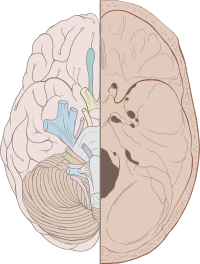
Photo from wikipedia
Aim To assess the fine sensation of palms and soles in field conditions, to enable early detection of nerve function impairment before the loss of protective sensation, thus preventing the… Click to show full abstract
Aim To assess the fine sensation of palms and soles in field conditions, to enable early detection of nerve function impairment before the loss of protective sensation, thus preventing the development of disability. Methods A cross-sectional descriptive study was conducted at seven tertiary referral hospitals located in different states in India. This study included all newly diagnosed patients affected by leprosy, who were registered during the period between March 2011 and April 2012. A detailed history was taken along with charting and voluntary muscle testing /sensory testing (VMT/ST) for the diagnosed patients. The sensation was measured using 0.2 gm Semmes-Weinstein filaments for palms and 4 gm for soles first, followed by 2 gm Semmes-Weinstein filaments for palms and 10 gm for soles. Results Among the 374 patients, 106 were identified with sensory nerve function impairment. Of the 106 patients, 84 were identified with absence of both fine and protective sensation and 22 patients had a loss of fine touch sensation with protective sensation intact. Limitation This study was conducted only among patients who were newly diagnosed with leprosy. Hence, future longitudinal studies in a larger population will add more validity to the study. Conclusion The patients who had loss of fine sensation would have been missed by the normal leprosy programme protocol which uses 2 gm and 10 gm filaments for testing sensory loss before initiating steroid therapy. Further research is needed to determine whether testing for fine sensation with 0.2 gm Semmes-Weinstein filaments for palms and 4 gm for soles can be introduced at all specialized leprosy centres to detect nerve function impairment at an earlier stage followed by steroid therapy.
Journal Title: Indian journal of dermatology, venereology and leprology
Year Published: 2022
Link to full text (if available)
Share on Social Media: Sign Up to like & get
recommendations!